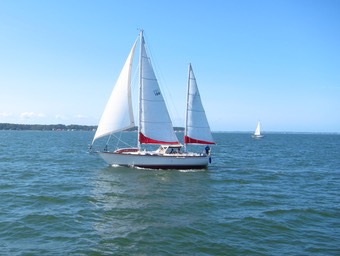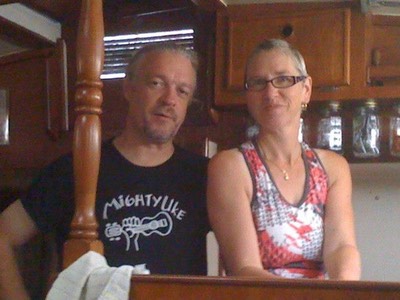The usual advice is measure twice cut once. But. We’re not there yet.
I’ve (finally) cut away enough of the top to reach inside and work. While it’s taken a bunch of weekends, it’s really one, long messy cutting job.
We wait for afternoons where it gets up to about 7°C, so it’s quite chilly for poor CA who’s handing me tools and waiting to hear if I drop a running saw on my foot.
I can now plan the two shelves to hold the two bladders. If you squint, you can see the blue sharpie lines. One is 11″ down from the top. The other is 22″ down. They make neat triangles, I think.

The master plan is to screw some supports onto the sides of the tank along the sketched lines. Then I can set two triangles of ⅜″ plywood on the supports.
The bottom berth’s triangle is 12″ across the aft end and about 13″ tall. Almost equilateral. While the triangle isn’t large, a 25″×25″ bladder can rest on this bunk and the sides of the tank.
The upper berth’s triangle is 34″ across the aft end and at least 43″ tall, so a 26″×45″ bladder will fit up here, nicely.
I’ve got wood and self-tapping screws for the aluminum: McMaster-Carr lists the screws for tapping into aluminum as 90203A629. I need some bilge paint for the wood, then I can cut some strips to support the bunks.
Then we’ll cut some cardboard to be sure I’ve measured the awkward bunks properly. We can all nod and smile about the triangular shape, but this is a boat.
Once we’ve got a sense of exactly what the shape is, we'll lay the cardboard out on my plywood to try and figure out how best to make the pieces. The plywood is in 24″×36″ sheets, so getting everything to fit is tricky. See this: McMaster-Carr 1125T24.

After a coat of bilge paint on the wood, I’ll be able to throw in the bladders. Since the lower bladder will be nearly inaccessible, I need to plumb it first and test it before adding the upper bladder.
After testing the lower bladder, I’ll have to cut the filler line to add a “T”. It also means adding a “Y” to the drain lines to combine the two bladders.
In this picture, you can barely see the triangle cut out of the lower portion of the aft wall of the tank. That was intended for the drain hoses to exit. There’s not enough clearance for the tubing. And razor-sharp aluminum edges that are hard to file smooth.
Measure once. Cut twice.
So I had to cut an extra hole.
I can file the edges smooth on this access window, wrap them in foam insulation used for home water pipes and run the two drains down into the plumbing confident they won’t chafe through.
Part V? Cut the supports and paint them. If the weather’s nice enough, we might be back the next day to install them and start shaping the bunks. Putting in the tanks is easy; testing them has to wait for the marina to turn on dock water.


